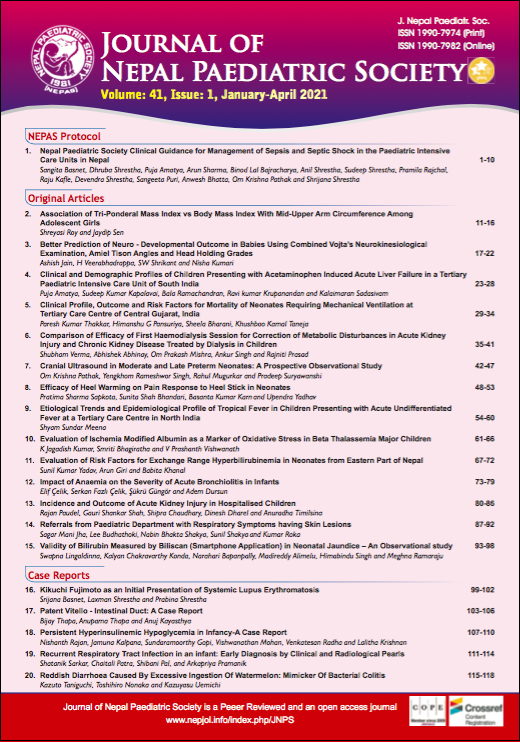Clinical Profile, Outcome and Risk Factors for Mortality of Neonates Requiring Mechanical Ventilation at Tertiary Care Centre of Central Gujarat, India
DOI:
https://doi.org/10.3126/jnps.v41i1.30630Keywords:
Mechanical ventilation, neonates, outcomeAbstract
Introduction: Mechanical ventilation is an important factor contributing to the reduced neonatal mortality in NICU. However, many ventilated babies are left with detrimental sequelae. This study was undertaken to know the prognostic predictors and survival outcome in the ventilated neonates. We assessed the clinical profile, outcome of mechanical ventilation and analysed the risk factors for mortality and complications resulting from mechanical ventilation.
Methods: A prospective study was conducted at the NICU of a tertiary care hospital in India. The study period was from May 2015 to April 2016. Neonates who underwent mechanical ventilation and met the inclusion criteria were enrolled in the study. Their demographic profile, outcomes and risk factors were documented and analysed using appropriate statistical methods.
Results: 285 neonates required mechanical ventilation during the study period. Among them, 190 were included in the study. Overall mortality was 99 out of the 190 enrolled (52%). The most common indications for mechanical ventilation were Respiratory Distress Syndrome (RDS), Meconium Aspiration Syndrome (MAS) and apnea. Risk factors contributing significantly to higher mortality of ventilated neonates were very low birth weight (VLBW), gestation of less than 32 weeks, shock, ventilator- associated complications like pneumothorax and pulmonary haemorrhage. In multiple regression analysis, very low birth weight, circulatory disturbances, pneumothorax, pulmonary haemorrhage, and higher initial FiO2 requirement were found to be independent risk factors of mortality.
Conclusions: The commonest indications for mechanical ventilation were RDS and MAS. Significantly higher mortality was seen amongst VLBW, preterm neonates. Co-morbidities like circulatory disturbance, and complications like pneumothorax and pulmonary haemorrhage contributed to adverse outcomes.
Downloads
Downloads
Published
How to Cite
Issue
Section
License
Authors who publish with this journal agree to the following terms:
Authors retain copyright and grant the journal right of first publication with the work simultaneously licensed under a Creative Commons Attribution License that allows others to share the work with an acknowledgement of the work's authorship and initial publication in this journal.
Authors are able to enter into separate, additional contractual arrangements for the non-exclusive distribution of the journal's published version of the work (e.g., post it to an institutional repository or publish it in a book), with an acknowledgement of its initial publication in this journal.
Authors are permitted and encouraged to post their work online (e.g., in institutional repositories or on their website) prior to and during the submission process, as it can lead to productive exchanges, as well as earlier and greater citation of published work (See The Effect of Open Access).



